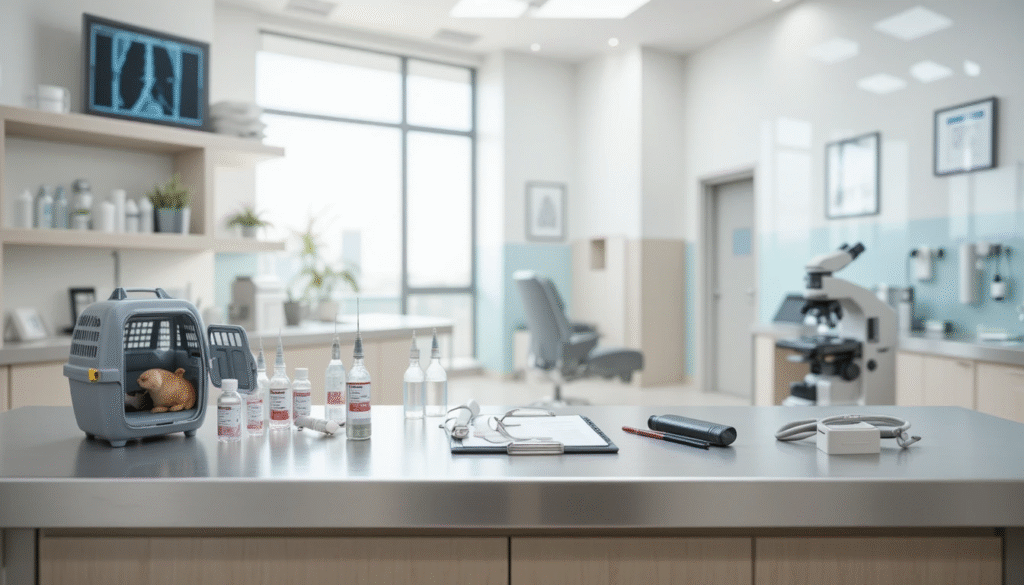
Taking your pet to the veterinarian can sometimes feel overwhelming, especially when medical terms and unfamiliar procedures come into play. Yet, understanding the most common veterinary treatments helps you make informed decisions, stay calm during appointments, and provide the best care for your companion.
This guide offers veterinary procedures explained in clear, simple terms. From routine vaccinations to diagnostic screenings, you’ll learn what each treatment involves and why it’s essential for your pet’s health. For accurate guidance or to locate a licensed veterinary facility near you, you can refer to an officially registered vet clinic in Dubai listed under the Dubai Municipality’s approved database.
Why Understanding Veterinary Procedures Matters
Pet care extends beyond daily feeding and playtime. Knowing what happens during veterinary visits can make a major difference in your pet’s well-being.
Strengthening Trust Between Owner and Vet
When you understand what your vet recommends—and why—you become an active participant in your pet’s healthcare. You’ll feel more confident asking questions about anesthesia, test results, or post-treatment care. This trust-based relationship leads to better collaboration and outcomes for your pet.
Reducing Pet Stress
Many animals sense when something unfamiliar is happening. When owners know what to expect, they can prepare their pets—through gentle acclimation, positive reinforcement, or simple routines. Familiarity with common procedures also helps owners stay calm, which in turn reassures their pets.
Routine Veterinary Procedures Explained
Routine procedures form the foundation of preventive pet care. They detect diseases early, prevent future issues, and keep pets healthy throughout their lives.
Spaying and Neutering
Spaying (for females) and neutering (for males) are among the most common veterinary surgeries. These procedures prevent unwanted litters, reduce the risk of reproductive cancers, and help curb behavioral problems like aggression or roaming.
Most pets can be spayed or neutered between 4 and 6 months of age. The surgery is performed under anesthesia, and recovery typically takes a few days with rest and restricted activity. Owners should monitor the incision site and follow their vet’s post-operative care instructions.
Dental Cleaning and Oral Exams
Dental care is often overlooked but essential for long-term health. During a veterinary dental cleaning, pets are placed under anesthesia so the vet can safely remove tartar buildup, examine teeth for decay, and polish the surface.
Neglecting dental hygiene can lead to gingivitis, tooth loss, or infections that spread to major organs. Warning signs include bad breath, difficulty chewing, and drooling. Regular cleanings, along with at-home brushing, keep your pet’s mouth healthy and pain-free.
Vaccinations
Vaccinations are vital for disease prevention. They protect pets from serious and often contagious illnesses.
-
Dogs typically receive core vaccines such as rabies, distemper, hepatitis, and parvovirus. Non-core vaccines, including leptospirosis or kennel cough, may be added depending on exposure risk.
-
Cats receive core vaccines like rabies, feline viral rhinotracheitis, calicivirus, and panleukopenia. Optional vaccines, such as feline leukemia, are recommended for outdoor cats.
Vets tailor vaccination schedules based on your pet’s age, lifestyle, and medical history. Puppies and kittens require several rounds of vaccinations in their first months, followed by booster shots every one to three years.
Microchipping and Identification
A microchip is a small, permanent form of identification placed under your pet’s skin. The procedure is quick, safe, and nearly painless. Each chip contains a unique number linked to a national or regional database with your contact information.
In many places, including Dubai, microchipping is mandatory for pet registration. It’s the fastest and most reliable way to reunite lost pets with their owners.
Blood Tests and Diagnostic Screenings
Bloodwork and imaging are essential diagnostic tools. Even healthy pets benefit from annual screenings to catch underlying conditions before symptoms appear.
Common diagnostic tests include:
-
Complete Blood Count (CBC): Evaluates red and white blood cells for infections or anemia.
-
Biochemical Profile: Assesses organ function—liver, kidneys, and pancreas.
-
Urinalysis: Checks hydration, kidney health, and urinary infections.
-
X-rays and Ultrasounds: Visualize internal organs, fractures, or tumors.
Diagnostics help veterinarians detect issues early, monitor ongoing conditions, and guide treatment plans.
Emergency and Specialized Veterinary Procedures
Sometimes, pets require urgent or complex medical attention. Understanding these situations prepares you to act quickly and confidently.
Surgery and Anesthesia
Beyond routine spaying or neutering, surgery may be necessary for tumor removals, orthopedic injuries, or internal complications. Modern anesthesia is safe, and veterinarians monitor heart rate, oxygen levels, and temperature throughout the procedure.
Post-surgical care includes rest, limited movement, and follow-up appointments. Veterinarians also provide pain management options to keep recovery comfortable.
Rehabilitation and Physical Therapy
Just like humans, pets benefit from rehabilitation after surgery or injury. Veterinary rehabilitation may include hydrotherapy (water exercises), massage, laser therapy, and mobility exercises.
These treatments strengthen muscles, improve flexibility, and accelerate recovery. They’re particularly useful for senior pets or those recovering from joint surgeries.
How to Prepare Your Pet for a Veterinary Procedure
Preparation makes any procedure safer and less stressful for your pet.
-
Follow fasting instructions: If your vet recommends fasting before anesthesia, ensure your pet doesn’t eat or drink within the given timeframe.
-
Share complete medical history: Inform your vet about allergies, medications, or prior surgeries.
-
Reduce stress before the visit: Keep travel calm—use carriers for cats, seat belts or harnesses for dogs, and familiar toys for comfort.
-
Plan post-procedure care: Arrange a quiet recovery space at home and monitor eating, behavior, and wound healing closely.
Communicating openly with your vet helps prevent complications and builds confidence during treatment.
Common Follow-Up Procedures and Aftercare
After most treatments, your vet may recommend follow-up visits to ensure healing and progress.
-
Post-surgery checkups: To assess wound healing and remove stitches.
-
Dental rechecks: Usually after professional cleanings or extractions.
-
Booster vaccinations: Timely doses maintain immunity against key diseases.
-
Lab re-evaluations: Help track chronic conditions or medication effectiveness.
Good aftercare often determines the success of a procedure, especially for surgeries and chronic conditions.
Communicating Effectively with Your Vet
Your veterinarian is your partner in your pet’s health journey. To make the most of each visit:
-
Prepare a list of questions beforehand.
-
Take notes on medications and instructions.
-
Ask about possible side effects or warning signs to watch for.
-
Don’t hesitate to request explanations in simple terms if something feels unclear.
Veterinary professionals appreciate informed owners who take an active interest in their pets’ care—it helps ensure smoother treatment experiences.
Empowering Pet Owners Through Knowledge
Understanding basic veterinary procedures empowers pet owners to make informed choices and detect potential problems early. Preventive care, timely treatment, and post-procedure follow-ups all contribute to a healthier, longer life for your pet.
Being informed also minimizes anxiety—for both owner and animal—during medical visits. When you know what’s happening, every appointment becomes an opportunity to strengthen your bond with your pet and ensure their well-being.
Conclusion
Veterinary care isn’t limited to emergencies—it’s a proactive way to keep your pet healthy, comfortable, and happy. By learning about these pet medical treatments, you gain insight into how veterinarians prevent and manage illnesses.
Whether your pet needs a simple dental cleaning, annual vaccination, or diagnostic test, understanding these procedures ensures you’re always one step ahead in their care.




